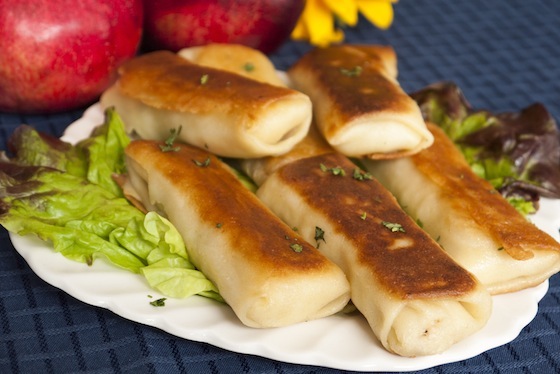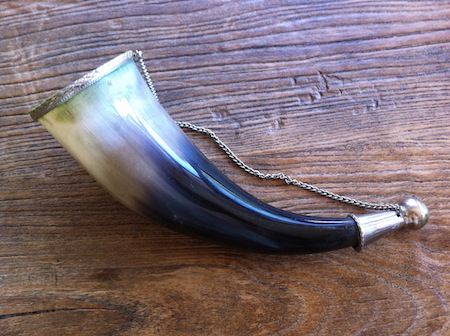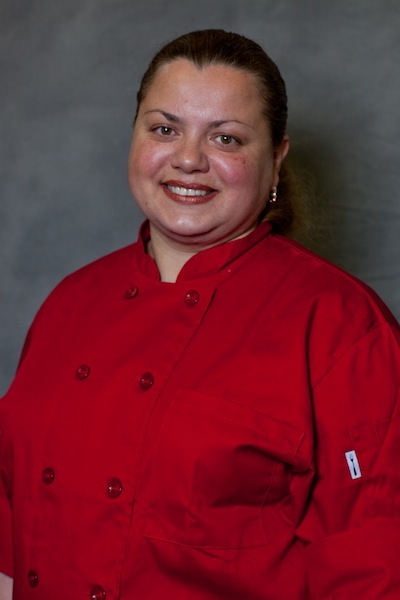
Chicken blintzes. Photo courtesy John Ater
2) Chicken Blintzes with “Georgian “Salsa”: These chicken blintzes honor both of Ghlonti’s parents. Her mother is Russian, her father Georgian. “Mom's favorite dish is blintzes. She taught me how to make them by hand. The chicken is baked, then ground with fried onion, pepper and salt. Served with adjika, a Georgian version of salsa, “made from tomato, chili pepper, bell pepper, garlic dill, cilantro -- it’s good with meat or fish."
3) Georgian Sangria: a blend of red grape, cranberry, apple, and pomegranate juices. Pomegranates are an important part of Georgian cuisine. “In Georgia, you can find them all yearlong at farmers' markets. But here pomegranates are seasonal, so I can use pomegranate molasses,” Ghlonti says.
Bay Area Bites interviewed Lali Ghlonti at her beloved La Cocina:
Georgian cuisine doesn't seem to be very well known yet. What are some of its typical ingredients?
Georgian dishes use herbs like cilantro, onions, red pepper, fenugreek, coriander, pomegranate, fish, meat and lamb, chicken. Fenugreek was hard to find when I first moved here, but then I found it at Whole Foods and when I go to Georgia to visit I bring some back here. Georgian cuisine has absorbed the best culinary influences of its neighbors and we love meat, eggplant, soups, nuts and spices. It’s also one of the most ancient wine making cultures too.
Do Americans have any misconceptions when they find out you are from Georgia?
Yes. They don’t know where Georgia is; they think I am from the state of Georgia or from Russia. The Georgian language is completely different from Russian, with a completely different alphabet. I married a guy from Odessa. I speak Russian as well as Georgian. In Georgia, everyone loves to cook, men too. My father cooked at least two times a week. He made a good chicken satsivi with walnut sauce.
I've heard Georgians have a culinary tradition of holding feasts. Can you tell me what they are like?
Georgian people are famous for their hospitality. Feasts are very important. You can have 100 people at a feast, which may go on all night. You always have a toastmaster, called a Tamada who is in charge, a strong guy who can really drink. He uses a horn decorated with silver to make many toasts with red wine. He could make 50 toasts to parents, elders and guests. See, with the horn shape, he has to finish every drink because he can’t put it down on table. Toasts are even made to ideas like life, love, friendship. Each person around the table expresses their personal understanding of these abstract concepts. The feast and toasts go on all day, while new platters of food are brought. It continues the next day with what we call hangover soup, khashi -- that’s made from the cows’ stomach and legs.
You just got selected to be one of the five businesses at the former Red Vic Movie House on Haight Street. Are you excited?
The second happiest day of my life was when I found out I was accepted for the Second Act Marketplace which will be part of the former Red Vic Movie House. It's set to open in March of 2013. I’ll have a small stand to make Georgian pastries. This really means a lot. My dream is to open a café so I can grow the finances to bring my parents here from Georgia. My café would be the first in San Francisco to serve authentic Georgian cuisine. There’s a Russian restaurant here that says they serve Georgian food. I tried it, but it wasn’t the real Georgian food. You don’t know it unless you lived in Georgia.
At the SF Street Food Festival look for Lali between 20th and 21st streets. She’ll be cooking blintzes for 500 people, and small bites of kidney bean spread and corn bread for 700.

Georgian drinking horn. Photo courtesy Lali Ghlonti
Lali's Catering
Website: lalisf.com
Facebook: Lali's
Twitter: @laliscatering



